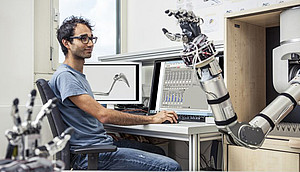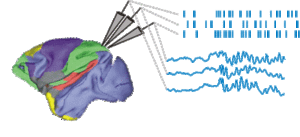At our institute Prof. Dr. Alexander Gail and his team of the Sensorimotor Group and Prof. Dr. Hansjörg Scherberger and his research group Neurobiology are working within the field of Neuroprosthetics.
Like normal prosthetics, Neuroprosthetics are medical auxiliaries that help people with impaired bodily functions to regain them partially. The specific area of application for Neuroprosthetics is the defective communication between the brain (motor planning) and a body part (movement). An impaired communication between the brain and the body detracts or hinders movement of the affected body part completely. An example is the paraplegia. Arms and legs are often intact but the related nerve tracts are damaged. Theoretically, it is possible to bridge such damaged nerve tracts - and this is the goal of Neuroprosthetics. Several studies on monkeys and paraplegic patients have demonstrated that electrodes that are implanted into the movement control spots of the brain can read the signals for arms or legs. A decoder then submits the signal via an artificial nerve tract to the muscle. But, amongst other unsolved issues, we still need much more information about the localization of those control spots within the brain to create properly working Neuroprosthetics.
Videos about neuroprosthetics
Fine Motor Skills for Robotic Hands
Bernstein TV: Decision and action - A matter of nerves
Spektrum Verlag: Saving the damaged Spinal Marrow (mostly in German)
Additional Links
The committee of experts actively supports the communication and discussion about recent developments in the areas of Neuroprosthetics, Neurological Stimulation, and Intelligent Implants. Current issues in technological innovations, methods of testing and control of auxiliaries are at the center of our activities.






